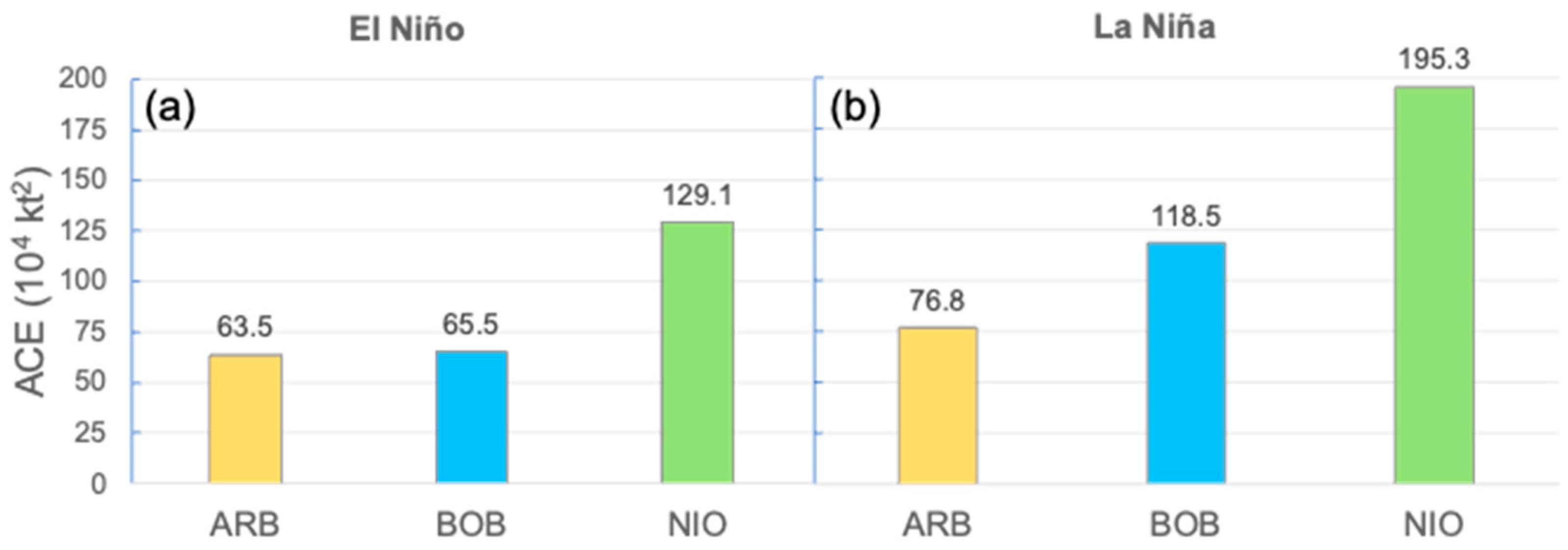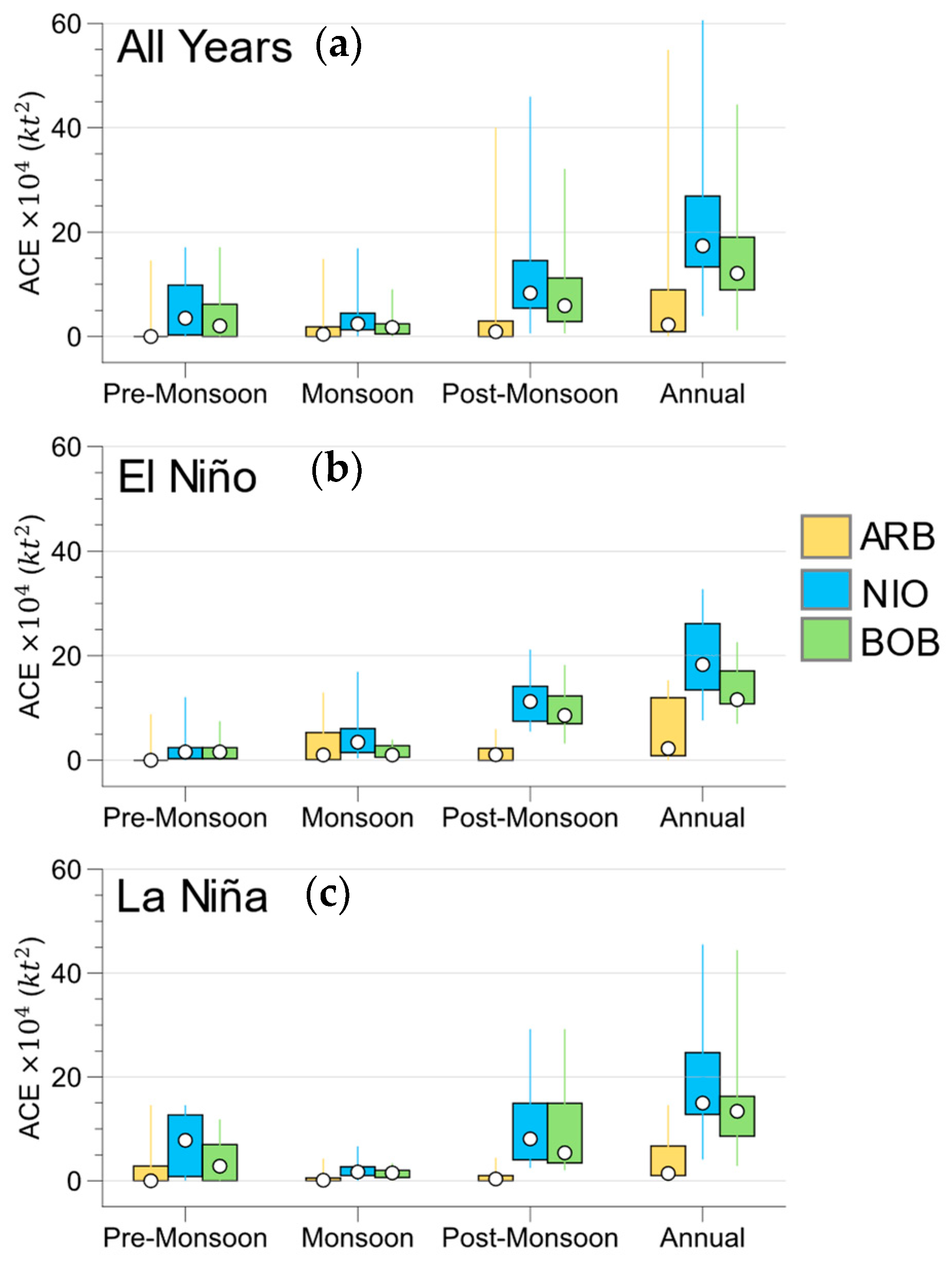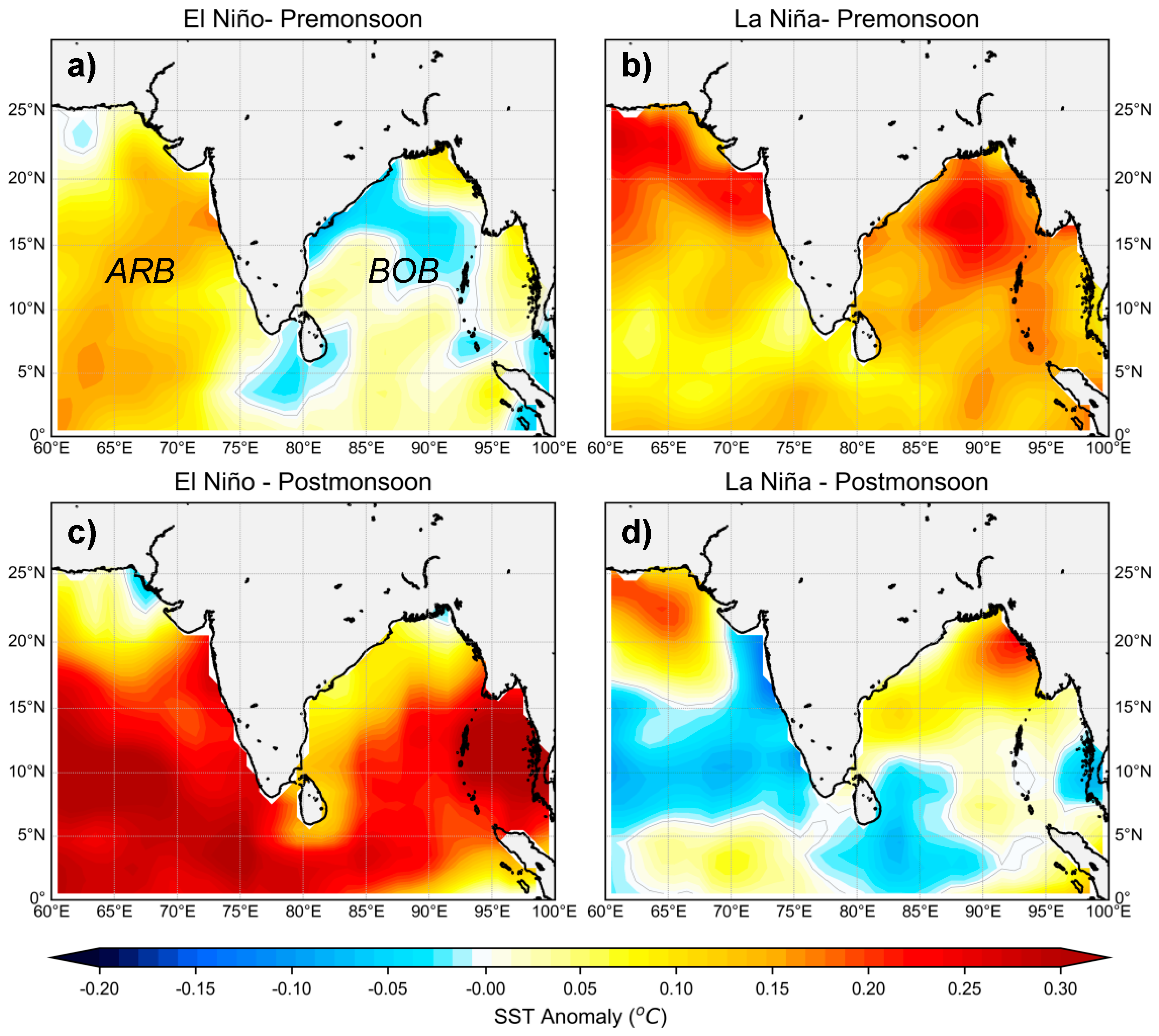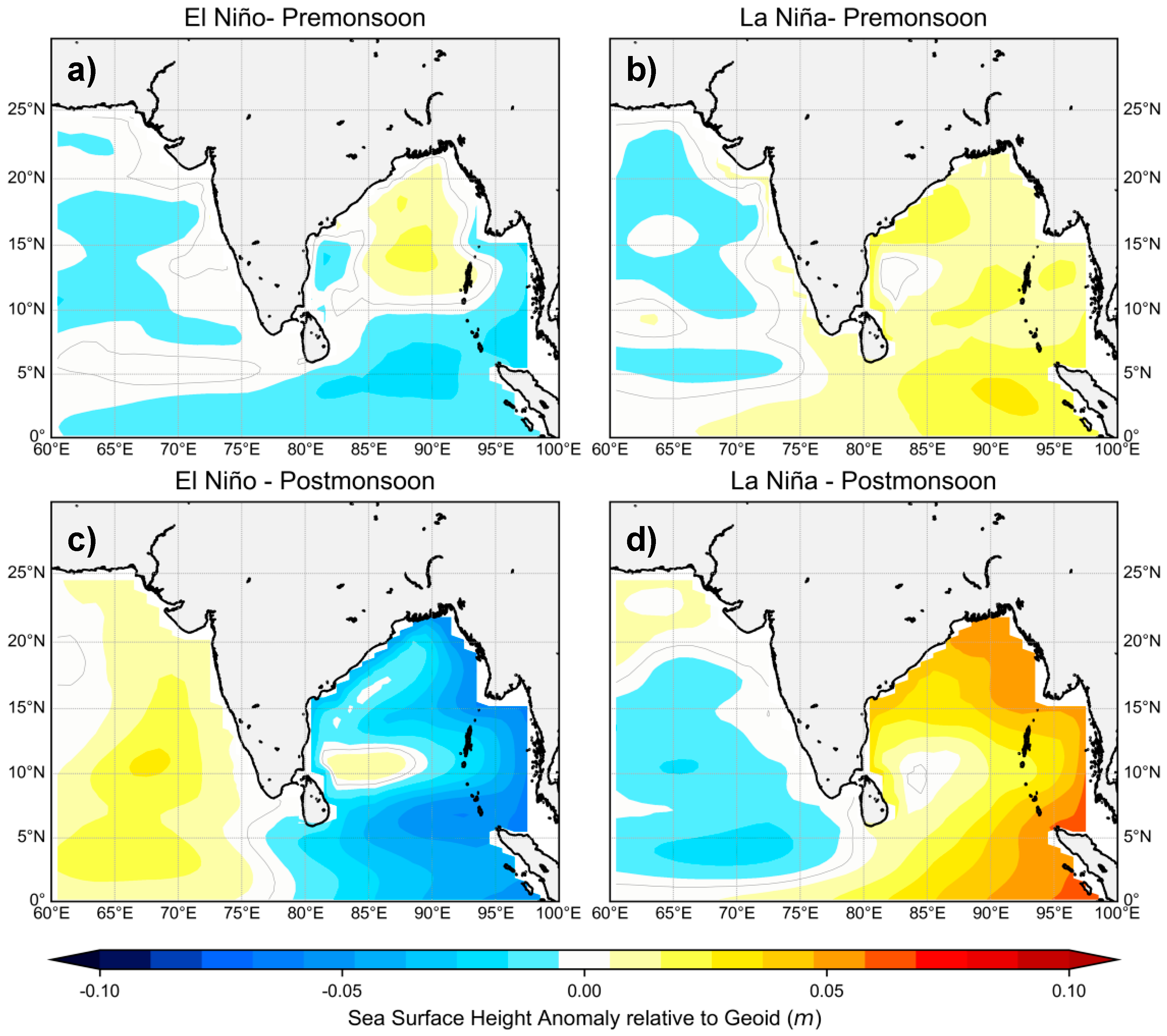Tropical Cyclonic Energy Variability in North Indian Ocean: Insights from ENSO
Abstract
:1. Introduction
2. Data and Methods
2.1. Data
2.2. Methodology
3. Results
3.1. ACE Variability across the North Indian Ocean, Arabian Sea, and Bay of Bengal Basins
3.2. Spatio-Temporal Variability of Atmospheric and Oceanic Modulation during ENSO Phases
4. Conclusions
Author Contributions
Funding
Data Availability Statement
Conflicts of Interest
References
- Lin, I.-I.; Chen, C.-H.; Pun, I.-F.; Liu, W.T.; Wu, C.-C. Warm Ocean Anomaly, Air Sea Fluxes, and the Rapid Intensification of Tropical Cyclone Nargis (2008). Geophys. Res. Lett. 2009, 36. [Google Scholar] [CrossRef]
- Tiwari, G.; Kumar, P.; Javed, A.; Mishra, A.K.; Routray, A. Assessing Tropical Cyclones Characteristics over the Arabian Sea and Bay of Bengal in the Recent Decades. Meteorol. Atmos. Phys. 2022, 134, 44. [Google Scholar] [CrossRef]
- Vecchi, G.A.; Soden, B.J. Effect of Remote Sea Surface Temperature Change on Tropical Cyclone Potential Intensity. Nature 2007, 450, 1066–1070. [Google Scholar] [CrossRef] [PubMed]
- Simpson, R.H. The Hurricane Disaster—Potential Scale. Weatherwise 1974, 27, 169–186. [Google Scholar] [CrossRef]
- Thiébaux, J.; Rogers, E.; Wang, W.; Katz, B. A New High-Resolution Blended Real-Time Global Sea Surface Temperature Analysis. Bull. Am. Meteorol. Soc. 2003, 84, 645–656. [Google Scholar] [CrossRef]
- Klotzbach, P.J. Trends in Global Tropical Cyclone Activity over the Past Twenty Years (1986–2005). Geophys. Res. Lett. 2006, 33. [Google Scholar] [CrossRef]
- Gray, M.W. Hurricanes: Their Formation, Structure and Likely Role in the General Circulation. Meteorology over the tropical oceans. Roy. Meteor. Soc. 1979, 155–218, CRID.1570291224529162496. NII Article ID:10006708334. [Google Scholar]
- Webster, P.J.; Holland, G.J.; Curry, J.A.; Chang, H.-R. Changes in Tropical Cyclone Number, Duration, and Intensity in a Warming Environment. Science 2005, 309, 1844–1846. [Google Scholar] [CrossRef]
- Lakshani, W.A.E.; Zhou, W. Observed Decadal Shifts and Trends in Global Tropical Cyclone Activities from 1980 to 2021. Atmos. Ocean. Sci. Lett. 2023, 16, 100321. [Google Scholar] [CrossRef]
- Gray, W.M. Tropical Cyclone Genesis. Ph.D. Thesis, Colorado State University, Fort Collins, CO, USA, March 1975. Atmospheric Science Paper No. 234. [Google Scholar]
- Ho, C.-H.; Kim, J.-H.; Jeong, J.-H.; Kim, H.-S.; Chen, D. Variation of Tropical Cyclone Activity in the South Indian Ocean: El Niño–Southern Oscillation and Madden-Julian Oscillation Effects. J. Geophys. Res. Atmos. 2006, 111, D22. [Google Scholar] [CrossRef]
- Chia, H.H.; Ropelewski, C.F. The Interannual Variability in the Genesis Location of Tropical Cyclones in the Northwest Pacific. J. Clim. 2002, 15, 2934–2944. [Google Scholar] [CrossRef]
- Goswami, B.N.; Ajayamohan, R.S.; Xavier, P.K.; Sengupta, D. Clustering of Synoptic Activity by Indian Summer Monsoon Intraseasonal Oscillations. Geophys. Res. Lett. 2003, 30. [Google Scholar] [CrossRef]
- Ali, M.M.; Swain, D.; Kashyap, T.; McCreary, J.P.; Nagamani, P.V. Relationship Between Cyclone Intensities and Sea Surface Temperature in the Tropical Indian Ocean. IEEE Geosci. Remote Sens. Lett. 2013, 10, 841–844. [Google Scholar] [CrossRef]
- Gray, W.M. Atlantic Seasonal Hurricane Frequency. Part I: El Niño and 30 Mb Quasi-Biennial Oscillation Influences. Mon. Weather Rev. 1984, 112, 1649–1668. [Google Scholar] [CrossRef]
- Goldenberg, S.B.; Shapiro, L.J. Physical Mechanisms for the Association of El Niño and West African Rainfall with Atlantic Major Hurricane Activity. J. Clim. 1996, 9, 1169–1187. [Google Scholar] [CrossRef]
- Villarini, G.; Vecchi, G.A. North Atlantic Power Dissipation Index (PDI) and Accumulated Cyclone Energy (ACE): Statistical Modeling and Sensitivity to Sea Surface Temperature Changes. J. Clim. 2012, 25, 625–637. [Google Scholar] [CrossRef]
- Wang, B.; Chan, J.C.L. How Strong ENSO Events Affect Tropical Storm Activity over the Western North Pacific. J. Clim. 2002, 15, 1643–1658. [Google Scholar] [CrossRef]
- Franzke, C.L.E.; Torelló i Sentelles, H. Risk of Extreme High Fatalities Due to Weather and Climate Hazards and Its Connection to Large-Scale Climate Variability. Clim. Chang. 2020, 162, 507–525. [Google Scholar] [CrossRef]
- Chaudhuri, S.; Basu, D.; Das, D.; Goswami, S.; Varshney, S. Swarm Intelligence and Neural Nets in Forecasting the Maximum Sustained Wind Speed along the Track of Tropical Cyclones over Bay of Bengal. Nat. Hazards 2017, 87, 1413–1433. [Google Scholar] [CrossRef]
- Chaudhuri, S.; Dutta, D.; Goswami, S.; Middey, A. Track and Intensity Forecast of Tropical Cyclones over the North Indian Ocean with Multilayer Feed Forward Neural Nets. Meteorol. Appl. 2015, 22, 563–575. [Google Scholar] [CrossRef]
- Bessafi, M.; Wheeler, M.C. Modulation of south Indian Ocean tropical cyclones by the Madden-Julian Oscillation and convectively-coupled equatorial waves, Mon. Weather Rev. 2006, 134, 638–656. [Google Scholar] [CrossRef]
- Ogata, T. Seasonality of Relationship between Tropical Cyclone Frequency over the Southern Hemisphere and Tropical Climate Modes. Atmosphere 2023, 14, 546. [Google Scholar] [CrossRef]
- Ke, M.; Wang, Z.; Pan, W.; Luo, H.; Yang, S.; Guo, R. Extremely Strong Western Pacific Subtropical High in May 2021 Following a La Niña Event: Role of the Persistent Convective Forcing over the Indian Ocean. Asia-Pac. J. Atmos. Sci. 2023, 59, 47–58. [Google Scholar] [CrossRef]
- Landsea, C.W.; Pielke, R.A.; Mestas-Nuñez, A.M.; Knaff, J.A. Atlantic Basin Hurricanes: Indices of Climatic Changes. Clim. Chang. 1999, 42, 89–129. [Google Scholar] [CrossRef]
- Lin, I.-I.; Camargo, S.J.; Patricola, C.M.; Boucharel, J.; Chand, S.; Klotzbach, P.; Chan, J.C.L.; Wang, B.; Chang, P.; Li, T.; et al. ENSO and Tropical Cyclones. In El Niño Southern Oscillation in a Changing Climate; American Geophysical Union (AGU): Washington, DC, USA, 2020; pp. 377–408. ISBN 978-1-119-54816-4. [Google Scholar]
- Kikuchi, K.; Wang, B.; Fudeyasu, H. Genesis of Tropical Cyclone Nargis Revealed by Multiple Satellite Observations. Geophys. Res. Lett. 2009, 36. [Google Scholar] [CrossRef]
- Albert, J.; Krishnan, A.; Bhaskaran, P.K.; Singh, K.S. Role and Influence of Key Atmospheric Parameters in Large-Scale Environmental Flow Associated with Tropical Cyclogenesis and ENSO in the North Indian Ocean Basin. Clim. Dyn. 2022, 58, 17–34. [Google Scholar] [CrossRef]
- Waple, A.M.; Lawrimore, J.H.; Halpert, M.S.; Bell, G.D.; Higgins, W.; Lyon, B.; Menne, M.J.; Gleason, K.L.; Schnell, R.C.; Christy, J.R.; et al. Climate Assessment for 2001. Bull. Am. Meteorol. Soc. 2002, 83, S1–S62. [Google Scholar] [CrossRef]
- Bell, G.; Halpert, M.; Schnell, R.; Higgins, R.; Lawrimore, J.; Kousky, V.; Tinker, R.; Thiaw, W.; Chelliah, M.; Artusa, A. The 1999 North Atlantic and Eastern North Pacific Hurricane Seasons [in “Climate Assessment for 1999”]. Bull. Am. Meteorol. Soc. 2000, 81, S19–S22. [Google Scholar]
- Maue, R.N. Recent Historically Low Global Tropical Cyclone Activity. Geophys. Res. Lett. 2011, 38. [Google Scholar] [CrossRef]
- Bamston, A.G.; Chelliah, M.; Goldenberg, S.B. Documentation of a Highly ENSO-related Sst Region in the Equatorial Pacific: Research Note. Atmos. Ocean 1997, 35, 367–383. [Google Scholar] [CrossRef]
- Fahad, A.A.; Reale, O.; Molod, A.; Sany, T.A.; Ahammad, M.T.; Menemenlis, D. The Role of Tropical Easterly Jet on the Bay of Bengal’s Tropical Cyclones: Observed Climatology and Future Projection. J. Clim. 2023, 36, 5825–5840. [Google Scholar] [CrossRef]
- Klotzbach, P.J.; Wood, K.M.; Schreck III, C.J.; Bowen, S.G.; Patricola, C.M.; Bell, M.M. Trends in Global Tropical Cyclone Activity: 1990–2021. Geophys. Res. Lett. 2022, 49, e2021GL095774. [Google Scholar] [CrossRef]
- Banacos, P.C. Box and Whisker Plots for Local Climate Datasets: Interpretation and Creation Using Excel 2007/2010.2011. Eastern Region Technical Attachment No. 2011-01. Available online: https://repository.library.noaa.gov/view/noaa/6605.12.11.23 (accessed on 1 November 2023).
- Das, D.; Chakrabarty, M.; Goswami, S.; Basu, D.; Chaudhuri, S. Impact of Intra-Seasonal Oscillations of Indian Summer Monsoon on Biogeochemical Constituents of North Indian Ocean. Theor. Appl. Climatol. 2019, 136, 839–848. [Google Scholar] [CrossRef]
- Kanamitsu, M.; Ebisuzaki, W.; Woollen, J.; Yang, S.-K.; Hnilo, J.J.; Fiorino, M.; Potter, G.L. NCEP–DOE AMIP-II Reanalysis (R-2). Bull. Am. Meteorol. Soc. 2002, 83, 1631–1644. [Google Scholar] [CrossRef]
- Tziperman, E.; Cane, M.A.; Zebiak, S.E.; Xue, Y.; Blumenthal, B. Locking of El Nino’s Peak Time to the End of the Calendar Year in the Delayed Oscillator Picture of ENSO. J. Clim. 1998, 11, 2191–2199. [Google Scholar] [CrossRef]







| Season | ENSO | Basin | D | DD | CS | SCS | VSCS | ESCS | SUCS |
|---|---|---|---|---|---|---|---|---|---|
| Pre-Monsoon | El Nino | AS | 78 | 54 | 216 | 66 | 0 | 0 | 0 |
| BOB | 138 | 108 | 330 | 102 | 90 | 102 | 24 | ||
| La-Nina | AS | 60 | 108 | 90 | 12 | 48 | 102 | 0 | |
| BOB | 282 | 132 | 162 | 84 | 0 | 0 | 0 | ||
| Post-Monsoon | El Nino | AS | 258 | 252 | 384 | 186 | 120 | 210 | 0 |
| BOB | 564 | 264 | 570 | 30 | 0 | 0 | 0 | ||
| La-Nina | AS | 528 | 564 | 174 | 60 | 0 | 0 | 0 | |
| BOB | 570 | 462 | 456 | 234 | 288 | 216 | 0 |
| Season | ENSO | Basin | CS | SCS | VSCS | ESCS | SUCS | Total |
|---|---|---|---|---|---|---|---|---|
| Pre-Monsoon | El Nino | ARB | 1 | 1 | 0 | 0 | 0 | 2 |
| BOB | 1 | 1 | 0 | 3 | 0 | 5 | ||
| La-Nina | ARB | 1 | 0 | 0 | 1 | 0 | 2 | |
| BOB | 2 | 2 | 0 | 0 | 0 | 4 | ||
| Post-Monsoon | El Nino | ARB | 2 | 3 | 2 | 4 | 0 | 11 |
| BOB | 7 | 0 | 0 | 0 | 0 | 7 | ||
| La-Nina | ARB | 1 | 0 | 0 | 1 | 0 | 2 | |
| BOB | 2 | 2 | 0 | 0 | 0 | 4 |
Disclaimer/Publisher’s Note: The statements, opinions and data contained in all publications are solely those of the individual author(s) and contributor(s) and not of MDPI and/or the editor(s). MDPI and/or the editor(s) disclaim responsibility for any injury to people or property resulting from any ideas, methods, instructions or products referred to in the content. |
© 2023 by the authors. Licensee MDPI, Basel, Switzerland. This article is an open access article distributed under the terms and conditions of the Creative Commons Attribution (CC BY) license (https://creativecommons.org/licenses/by/4.0/).
Share and Cite
Das, D.; Chiao, S.; Roychoudhury, C.; Khan, F.; Chaudhuri, S.; Mukherjee, S. Tropical Cyclonic Energy Variability in North Indian Ocean: Insights from ENSO. Climate 2023, 11, 232. https://doi.org/10.3390/cli11120232
Das D, Chiao S, Roychoudhury C, Khan F, Chaudhuri S, Mukherjee S. Tropical Cyclonic Energy Variability in North Indian Ocean: Insights from ENSO. Climate. 2023; 11(12):232. https://doi.org/10.3390/cli11120232
Chicago/Turabian StyleDas, Debanjana, Sen Chiao, Chayan Roychoudhury, Fatema Khan, Sutapa Chaudhuri, and Sayantika Mukherjee. 2023. "Tropical Cyclonic Energy Variability in North Indian Ocean: Insights from ENSO" Climate 11, no. 12: 232. https://doi.org/10.3390/cli11120232






